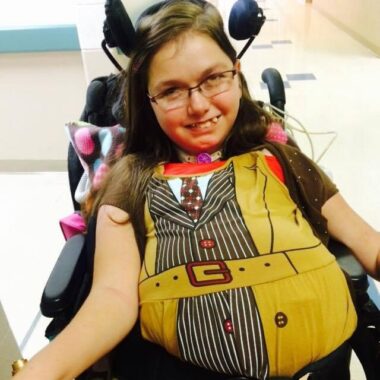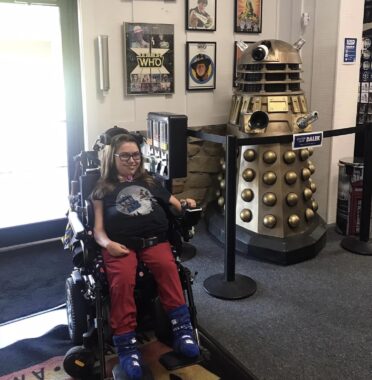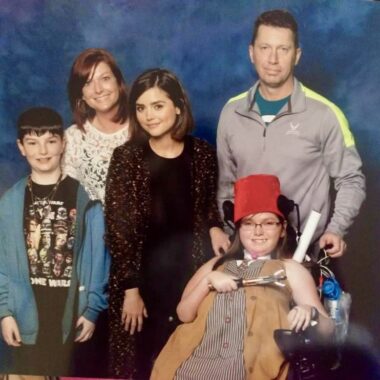A modern era of wheelchair-accessible time travel is finally here
In the 60th anniversary series of "Doctor Who," wait till you see the TARDIS

When rumors began circulating years ago that a certain blue police box time machine might be getting an accessible makeover, my interest was more than piqued. Would a ramp truly be added to the TARDIS when the British sci-fi show “Doctor Who” returned to the air late last year for three 60th anniversary special episodes? That would mean people like me with SMA and other disabilities could become The Doctor’s companions.
Leading up to the event, fans were treated and teased with tantalizing tidbits about the series. The special episodes would feature new friends, new monsters, and some favorite old faces. The fact that actors David Tennant and Catherine Tate were slated to reprise their roles as The Doctor and Donna Noble left most fans, myself included, with eager anticipation. But when would we hear more about that ramp?
(Spoiler alert: If you haven’t yet seen the special episodes, which aired in November and December, and you plan to, then read no further.)
‘I’d forgotten not all victories are about saving the universe’
The day finally arrived, and my family gathered around the television for the first of three episodes. It was better than I’d imagined: The story and cast delivered on every front. One highlight was the unveiling of a gorgeous new TARDIS interior that far exceeded my expectations.
I had thought we were talking about a singular ramp — nothing fancy, just something that would create an opportunity for physically disabled companions to travel with The Doctor. Instead, what we got was an artfully designed pathway that sweeps up through the control room in a swirl of breathtaking, functional accessibility. Every floor and doorway can now be accessed without stairs.
Of course, there was still the matter of the large threshold at the entrance that’s part of the time machine’s signature exterior design. This detail wasn’t overlooked, though. The third episode revealed that the step now flips out into a practical entry ramp that anyone can use. With this, the TARDIS became completely accessible for the first time and left me feeling wibbly wobbly, timey wimey in the best way.

For a 2014 Halloween party, Halsey Blocher dresses as David Tennant’s 10th Doctor from the British sci-fi series “Doctor Who. (Courtesy of Halsey Blocher)
‘Now you go with him. That wonderful doctor. Go and see the stars’
Some had speculated that the creation of accessibility on set was to accommodate actor Bernard Cribbins, who was believed to be returning for the anniversary episodes. Cribbins had played the beloved character Wilfred “Wilf” Mott, an alien enthusiast and Donna’s grandfather. In real life, he had become a wheelchair user since his previous time on the show. But when Cribbins passed away in July 2022 at 93, we fans mourned the loss and wondered if we’d ever see Wilf again.
Cribbins was able to film one scene before he died, unbeknownst to his fans. The second episode features his surprise final television appearance.

For her 25th birthday, Halsey Blocher visits the Who North America retail store and meets an iconic enemy of The Doctor, in September 2022. (Courtesy of Halsey Blocher)
‘I don’t just fire darts, mate’
As the broadcast dates drew nearer, I caught a glimpse in a trailer of a new character who also looked to be in a wheelchair. It happened so fast that it was easy to miss. (Don’t blink!)
This character turned out to be Shirley Anne Bingham, played by Ruth Madeley, a BAFTA Award nominee with spina bifida. Shirley proved to be an intelligent and powerful new ally to The Doctor. She instantly became one of my favorite “Doctor Who” characters of all time, and the gadgets hidden in her wheelchair are pretty cool, too.
The TV and movie website Digital Spy noted that the character of Shirley “will be, for many, the first time a fully-rounded, complex disabled person has been represented in their favorite TV show.” Fellow SMA News Today columnist Sherry Toh echoed this sentiment in a recent column titled “New ‘Doctor Who’ specials give me hope for disability representation.” Sherry was moved to tears by the sight of a disabled character that she connected with on a meaningful level.
Shirley hasn’t taken the TARDIS for a spin yet, but I’m hopeful she’ll return for another adventure in the future. Or maybe the past? Now that time travel is wheelchair-accessible, the possibilities are endless.
‘In 900 years of time and space, I’ve never met anyone who wasn’t important’
On the surface, an accessible time machine and a couple of disabled characters might not seem like a big deal, but I assure you that the implications are “bigger on the inside.” Donna Noble once taught us that ordinary things — and people — can have a big impact. When she met The Doctor back in season 4, Donna believed she was just a temp from Chiswick — nothing fancy. But she turned out to be the most important woman in the universe.
If all of time and space can be made accessible, then Earth can, too. If The Doctor and his companions can prioritize welcoming and including people with disabilities, so can we. If a sci-fi show can make a community feel seen, imagine the difference real people can make in the real world. That sounds like a pretty big deal to me.

Halsey Blocher and her family meet a famous “Doctor Who” actress, Jenna Coleman, center, at the Indiana Comic Con in 2015. (Courtesy of Halsey Blocher)
Note: SMA News Today is strictly a news and information website about the disease. It does not provide medical advice, diagnosis, or treatment. This content is not intended to be a substitute for professional medical advice, diagnosis, or treatment. Always seek the advice of your physician or other qualified health provider with any questions you may have regarding a medical condition. Never disregard professional medical advice or delay in seeking it because of something you have read on this website. The opinions expressed in this column are not those of SMA News Today or its parent company, Bionews, and are intended to spark discussion about issues pertaining to spinal muscular atrophy.









Rebecca Field
My dad loved Doctor Who and all things Science Fiction. He would often visit a Science Fiction shop in London in the 80's buying collectables. One item he bought for me was a Peter Davidson Doctor Who Moneybox tin. It still sits on my desk to this day, it is a most treasured possession of mine. We still love watching it as a family. Wonderful to see programmes like this becoming more inclusive. Thank you for this wonderful column, lovely to see how special Doctor Who has been to you.
Halsey Blocher
Thank you, Becky! I love hearing about your family’s love for Doctor Who and that it was something you enjoyed with your dad. It’s awesome that your family still watches it together. And your money box sounds really cool!